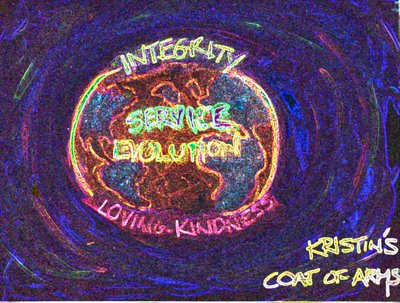Point One of the Seven Points of Mind Training (Lojong)
There's a Kalyana Mitta group, or "KM Group," that meets regularly at my house. In the Buddhist tradition Kalyana Mitta might translate to "spiritual friends." We are there to support one another in our practice and on our path. We meditate and then share our daily lives, our struggles and victories. When we talk we use the Mindful Dialogue technique which employs a talking stick or stone and where create space between shares and aspire to hold a space of listening, support and self-awareness. As my mentor and friend, La Sarmiento puts it, the mindful dialogue tecnique asks us to bring the practice we use in meditation to "conversation": rest in awareness, watch what happens, resist nothing, hold a gentle heart.
As a way to support each other on the path and bring a dharmic perspective to any struggles, our KM group has decided to walk through some Buddhist teachings. We're currently exploring Pema Chödrön's Start Where You Are which covers the "slogans" or teachings of the Seven Points of Training the Mind (Lojong). We all love Pema and wish she would join our KM group. Reading her books together is probably as close as we're going to get.

So, as a sample of our exploration, to give you a sense of what Buddhism is andi is becoming for me, I present a summary of the first few chapters covering Point One of the Seven Points of Mind Training followed by my personal reflections. Within the summary, I've elaborated a bit (in italics) with a personal aspiration that will help me to remember and put to work each of the slogans.
But first, a note on lists. Buddhists love their lists. The Buddhist sutras (or official teachings) are full of lists: the four noble truths, the eight-fold path, the seven points of mind training, the three poisons, etc, etc. Someone finally pointed out to me that this was necessary as Buddhism was for so long an oral tradition. To understand a concept (the path, the mind trainings), a list was the only way to make the teaching whole. Makes perfect sense now.
I've started to see the ways in which these concepts interrelate and cross-reference each other. So as I summarize Pema's teaching on point one of the seven points of mind training, there will be references to other Buddhists teachings, some of them fundamental. I won't explain all of those here (and there is a decent chance I got some of it wrong!), so if you're new to Buddhism, some of this won't make much sense. Instead, hang with what does make sense and let the rest go.
Point 1: The Preliminaries, the Basis for Dharma Practice
Point one covers sets the foundation for mind training: The Practice (as in, the meditation practice) and The View (this is the Buddhist way of seeing reality and is the first aspect of the 8-fold path). Pema describes how the The View relates to the buddhist concept of absolute bodhichitta. Given the translation of "bodhichitta" as the “awakened heart,” absolute bodhichitta emphasizes the awake sense of the awakened heart: opening up to the the full scope, confronting the Big Reality and contemplating unfathomable truth of the universe. So here we have in Point one, the foundation, The Practice and The View:
- First, train in the preliminaries.
Shamatha Vipashyana practice – consistent, ardent meditation practice is the foundation for the path.
If I ground myself in anything, it is the practice.
- Regard all dharma’s as dreams
Solidity is illusion, each situation passing memory.
The practice is precise, even ruthless. Within that precision, I explore and acknowledge with a warm and gentle heart. - Examine the nature of unborn awareness.
Even this “I” is an illusion.
I contemplate the nature of this one who hears these words, is aware, has insights, “understands.”
- Liberate even the antidote.
If I think I understand “Regard all dharmas as dreams” and/or “Examine the nature of unborn awareness,” then, well, think again.
Objectify nothing. Free even the understanding of emptiness.
- Rest in the nature of alaya, the essence.
This slippery place in which the mind feels deeply insecure is a wonderous place. It is reality. Rest there.
I return to and relax in open, spacious, wordless, formless presence.
- In post-meditation, be a child of illusion.
Off the meditation cushion, in the rest of your life, continue the practice.
I call myself on a path as I carry the awareness cultivated in meditation into daily life, in all of my relationships, activities, directions and intentions.
Thoughts On Point One
First, I love it that the seven points of mind training start with the fundamental requirement of meditation practice. What catching and throwing are to baseball, football, and, the highest form of sport, ultimate frisbee, meditation is to Buddhism. Pema and the lojong teachings don't let us off the hook: if you're not meditating, Buddhism is mere entertainment, perhaps even a philosophy, but not a way of life. If you're not meditating, you're a spectator. That might sound harsh, but I think it so ... but wait, is that the long-ago voice of my dear friend and teacher, Rhonda Williams, I hear? "None so righteous" she said, "None so righteous as the recently converted." Indeed, exploring the teachings in text and in discussions is a place on the path, the first place, a precious place. Okay, I take it back. But I will say that for me that place has an end and at some point I commit to the path and, in so doing, I commit to a daily practice. And if I falter, I recommit again.
Second, the rest of the slogans in this section, those that together illuminate the concept of absolute bodhichitta, blow my mind. And this seems exactly what they are intended to do: to shake my sense of certainty about the way I see the world; to call into question what I think I "know;" to call into question thinking itself; and to actively re-engage in wonder, wonder without conclusions, at the most fundamental level.
While she hasn’t gotten to it yet, we know that the other dimension of bodhichitta is relative bodhichitta, the heart aspect of the "awakened heart." This is our fundamental connectedness with each other and all of life in this field of formless presense, the stuff of natural compassion, how it is that we care for each other in order to care for ourselves.
The concept of bodhichitta is fundamental to the Mahayana Tradition of Buddism: the open mind and the open heart.
From my read, the two dimensions of Bodhichitta (absolute and relative) and three aspects Pema describes here (compassion, prajna and shunyata) significantly overlap:
- Relative bodhichitta and compassion are associated. This is the soft and gentle heart sense.
- Absolute bodhichitta and shunyata are also associated as the vast, open, emptiness sense.
- Then the third aspect of bodhichitta, prajna, is the clear and sharp even ruthless view of reality. It is this third aspect that informs a core willingness to see the other aspects, (indeed all things) as they are, even as we don’t understand them, even as they don’t really exist.
I feel so fortunate to have come upon the Dharma, the Buddhist view of life and truth. I am so very grateful to those, including Pema Chödrön, who have devoted their lives to the discovery, enhancement and transmission of the Dharma. And I am equally grateful to my KM group, my sangha, my spiritual community for sharing and exploring the path with me.
Labels: Evolution, Integrity, Loving-Kindness, Service






2 Comments:
I'd love to follow your blog as I was hoping to write one myself with similar intentions but I can't find a link on your site to add you...
Depending on your technology of choice, you have different options. Using the white box up top (below "About Me"), enter your email address to get new posts directly to your inbox. Alternatively, connect to my feed using a reader by clicking "Subscribe to my feed." You can also add my blog (www.kristinsworld.com) to your blogger dashboard if you have one. Let me know if that's not what you were looking for.
Post a Comment Hide comments